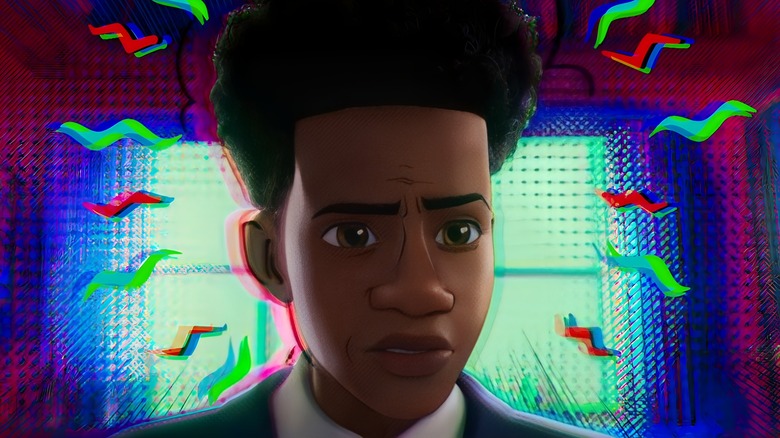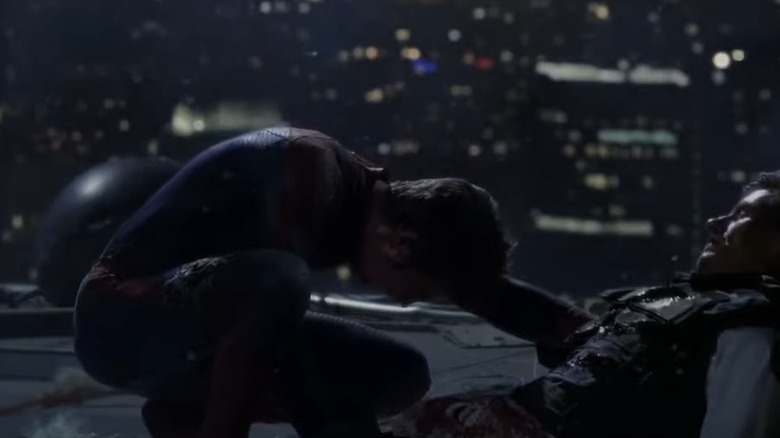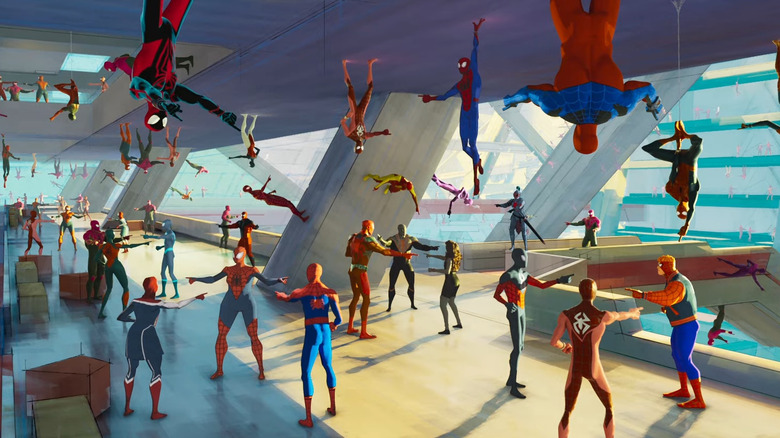Spider-Man: Across The Spider-Verse: [SPOILER]'s Cameo Makes No Sense
Contains spoilers for "Spider-Man: Across the Spider-Verse."
There are a truly disorienting amount of cameos, Easter eggs, and references for the most avid webheads in the audience to enjoy in Sony Pictures Animation's "Spider-Man: Across the Spider-Verse." With appearances from the Spider-Men of Insomniac's critically acclaimed PlayStation title (voiced by Yuri Lowenthal), the cult-classic animated series "Spectacular Spider-Man" (Josh Keaton), as well as the Donald Glover's The Prowler from the Marvel Cinematic Universe, there is no shortage of surprise inclusions that will have fans hollering in movie theaters for weeks to come.
However, despite being no less exciting to witness than other scenes, one particularly "Amazing" cameo is undeniably confusing when you consider how it fits into the story. As Miguel O'Hara (Oscar Isaac) explains the nature of so-called "canon events" (plot points in every Spider-Person's life that cannot be altered) to Miles Morales (Shameik Moore) in Nueva York, fans get a welcome glimpse of Andrew Garfield's Peter Parker from the 2012 Marc Webb film "The Amazing Spider-Man."
On the one hand, any moment to witness Garfield in a role that, let's face it, he was born to play is a gift to audiences, and the scene in "Spider-Verse" is better because of its presence. On the other hand, the "Amazing" scene doesn't fit with the strangely specific parameters set by the Spider-Man of 2099.
Captain Stacy's death in The Amazing Spider-Man doesn't fit Miguel's description of a canon event
The main problem with Andrew Garfield's scene is how it contradicts the canon event stated by Miguel. Per his dialogue, the event in every single universe sees a police captain close to Spider-Man killed while trying to save the life of a child.
Yet in the scene from "The Amazing Spider-Man," in which Peter cradles the body of a dying Captain George Stacy (Denis Leary), fans will probably remember that he didn't sacrifice himself for the life of a child. In the film, Captain Stacy is murdered while trying to help Peter defeat Dr. Curtis Connors (Rhys Ifans), who had transformed himself into the monstrous Lizard.
Though Miguel's borderline obsessive insistence that the Spider-Verse repeats itself in identical ways is meant to draw scrutiny, it's hard to believe in the context of the story that he would show this specific moment to showcase "a police captain dying to save a child." Perhaps an argument could be made that Captain Stacy somehow indirectly saved a child by preventing them from turning into a lizard along with the rest of New York (what a strange, strange film), but it's a bit of a stretch. It could also be argued that Miguel's curiously vague description was only meant to apply to the specific comic book moment shown. But given the overall message of the scene, the context of its placement, and the fact that Pavitr's police captain was also trying to save a child from falling rubble, it seems as though Miguel's statement was meant to apply to all Spider-People across the multiverse.
All that being said, the "factual inaccuracies" of this inclusion should be excused, not just because it's ultimately nitpicking or even because Garfield's Spidey is a joy to see, but because its just one of many instances of fan service in this movie that actually works in service of the story.
The scene still contributes to the message Miguel wants to communicate
Though the sheer amount of cameos in "Across the Spider-Verse" likely rivals the number of multiversal callbacks and Easter eggs seen in any superhero film to date, pretty much every single one contributes to the overall narrative. Just as "The Amazing Spider-Man" is used to underscore Miguel's point, that these canon events do occur (albeit inconsistently) in every single "Spider-Man" story, the film's other cameos and references actively progress the plot.
When The Spot (Jason Schwartzman) accidentally visits a Lego version of New York City, some audience members likely took it as a shockingly amusing sight gag. What's even more surprising is how the script commits to its presence within the story, and allows Lego Spider-Man to be the one that alerts Miguel to The Spot's existence. Similarly, Josh Keaton's Spectacular Spider-Man isn't a mere blink-and-you'll-miss-it cameo, but one of the Spider-People that shares their own experience in order to help Miles understand his own.
The synergy of reference humor and narrative weight is something producers Phil Lord and Chirs Miller nailed down while working on their career-defining animated work "The Lego Movie." Other franchise films hoping to mine nostalgia, in the same way, should take notice of how Lord and Miller are able to do so without sacrificing the integrity of their story and while allowing references to actually contribute to the plot.


